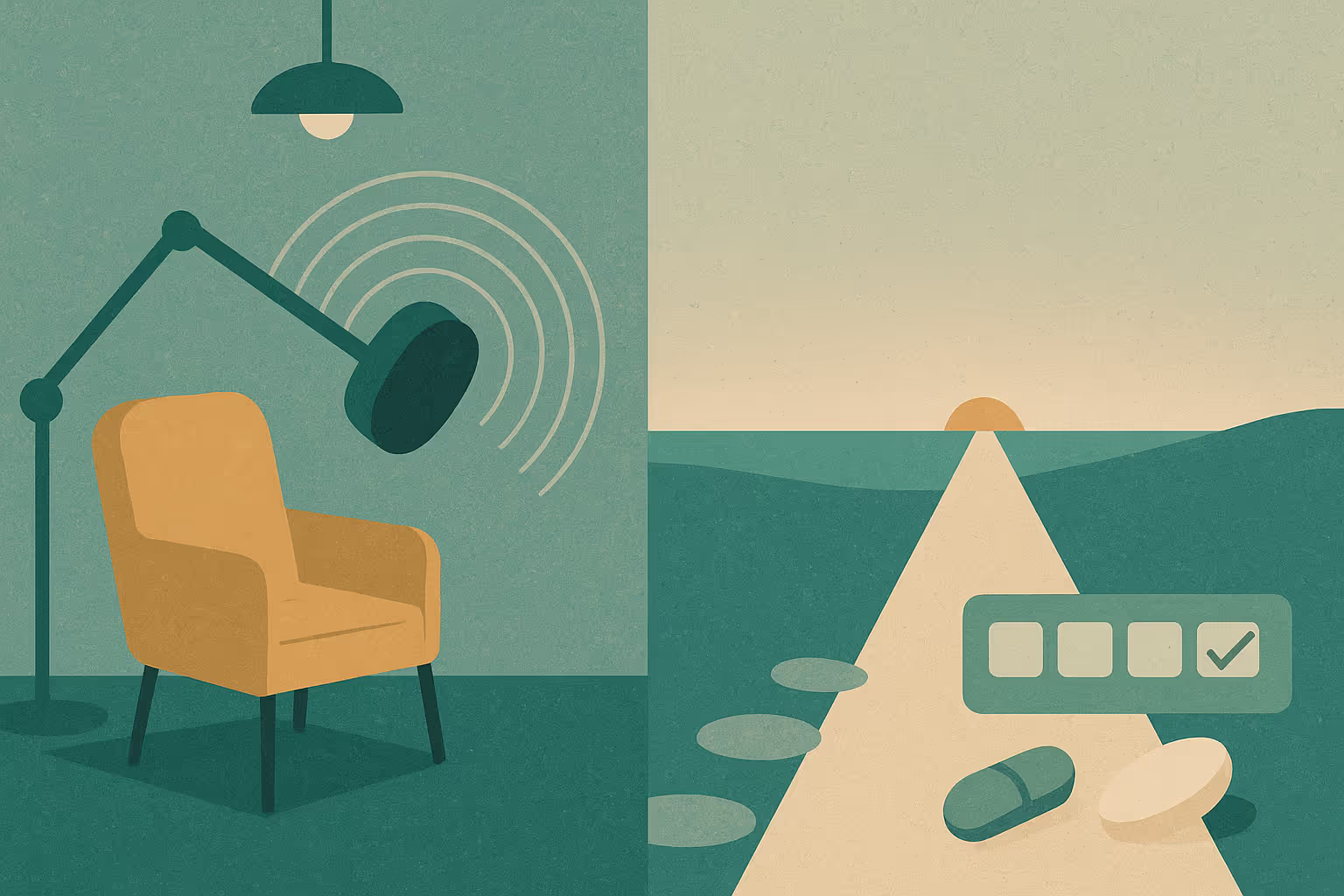When clinicians first reach out to Lumin Health about ketamine therapy or esketamine (Spravato), four common questions come up:
- How does ketamine therapy work?
- Is ketamine treatment safe?
- Who’s the right candidate for ketamine therapy / esketamine (Spravato)?
- And how do I stay connected to Lumin Health in the event that I refer a patient?
- How do I speak with patients about the treatment?
Dr. Ben Yudkoff, Chief Medical Officer of Lumin Health, revisited these questions through a clinical lens — one informed by evidence, experience, and the day-to-day reality of caring for people whose depression has resisted seemingly everything else.
The following Q&A distills Lumin Health’s philosophy into concise answers you can read in under ten minutes — designed to support care providing colleagues across disciplines: therapists, PCPs, hospital consult teams, EAPs, campus health clinicians, and more.
Fast Answers to Common Questions
Mechanisms & safety of ketamine treatment
Q: For colleagues new to this treatment, how do you describe what ketamine actually does?
Dr. Yudkoff:
“Most antidepressants work by addressing monoamines: serotonin, norepinephrine, and dopamine. Ketamine therapy works differently — it acts on glutamate, the brain’s main excitatory neurotransmitter. By briefly blocking NMDA receptors and amplifying AMPA signaling, it triggers a release of brain-derived neurotrophic factor (BDNF), which supports neuroplasticity — essentially, the growth of new neural connections. It also impacts different opioid receptors involved in endorphin communication and stress responses, astrocytic activity with implications for how the brain registers futility, and network connectivity (especially the default mode network) which help us make sense of the world around us before we think of the world around us.
I tell patients their brain isn’t broken, it’s just set into a mode that’s hard to get out of. Ketamine can help it get unstuck, creating a short window where learning, emotion, and flexibility can reconnect and where perception of ourselves and the world can shift. That’s why pairing it with psychotherapy or behavioral support is so important.”
Q: Is ketamine safe? The public image of ketamine can make that question hard to answer simply.
Dr. Yudkoff:
“That’s fair. The word ketamine carries baggage — from anesthesia to misuse narratives. In medical care, though, it’s safe, predictable, and can be meaningfully effective for patients with treatment-resistant depression. It’s a paradigm shift in thinking about how different compounds can promote wellness, and this can be challenging and result in reasonable skepticism. Patients are screened carefully for medical risks and psychiatric conditions that could portend undo risk before starting.
Sessions occur in private, comfortable, medically supervised rooms with continuous vital monitoring and post-dose observation. Most side effects are short-lived and in over fifty years of use in hospitals, ketamine has an extraordinary safety record when used appropriately.
All sites are team led — a psychiatric, psychiatric NP or PA, nurses, therapists. We present a full suite of expertise to help those who haven’t experienced satisfactory relief take new, defined steps in that direction. We believe in our work.
We’ve built Lumin’s protocol so nothing about it feels casual: each session is attended, intentional, tracked, and held with rigorous medical and emotional safety in equal measure.”
Ketamine therapy timelines & expectations
Q: How quickly do patients typically respond — and how do you frame that for referring clinicians?
Dr. Yudkoff:
“Some notice improvement within hours; others within weeks. The typical trajectory we see in both Spravato treatment and off-label ketamine therapy follows what I call four response stories: immediate, early, late, and non-response.
Immediate responders feel a shift in mood or clarity after one session. Early responders usually notice cumulative relief in weeks one to three. Late responders may need a full series before benefit is clear and is much less common. And some people, of course, don’t respond meaningfully at all.
We try to normalize that spectrum. Relief can be rapid, but it’s not a miracle cure. Our job is to hold hope steady without overpromising and being available to discuss next steps if treatment doesn’t work. We typically fit ketamine therapy responses into four categories, which you can learn more about here.
Q: How durable are the benefits of ketamine therapy?
Dr. Yudkoff:
“Acute benefit often lasts days to weeks. Maintenance sessions — spaced further apart — help sustain gains. But the real durability comes from what happens between sessions: behavioral support, lifestyle stability, and support within that neuroplastic window. That’s where biology becomes lived change.”
Esketamine (Spravato) and ketamine candidacy & exclusions
Q: What kinds of patients do you most often see referred?
Dr. Yudkoff:
“Mostly adults with treatment-resistant depression — people who’ve tried at least two antidepressants without relief. We also see major depression with suicidal thoughts, and occasionally comorbid anxiety or PTSD. The key question is whether other interventions have plateaued, whether the patient has stable support systems in place, and a call to action is requested by the patient.”
Q: Who’s not a good fit?
Dr. Yudkoff:
“There are some notable caution zones – including active psychosis, uncontrolled hypertension, or unstable substance use. Pregnancy is also a stop point as are other neurological or vascular disorders. Bipolar depression can be considered carefully, but only with mood stabilizers and close observation for mania. The point isn’t exclusion for exclusion’s sake — it’s protection. We’d rather delay treatment than destabilize someone who isn’t ready.
Every patient goes through a thorough evaluation at Lumin Health before first dosing — medical, psychiatric, and contextual. That’s how we make sure the treatment fits the person, not the other way around.”
How Lumin Health coordinates ketamine therapy as part of a care plan with providers
Q: Many clinicians worry about losing patients after referral. How does Lumin Health structure collaboration?
Dr. Yudkoff:
“That concern can come up — and it’s valid. The relationship between referring clinicians and patients is sacred. Our model is built to protect it.
Before treatment begins, Lumin Health always gets explicit consent to share updates. We send concise summaries after evaluation and key milestones (we model our practice with Q2 month communication with as needed communication interspersed throughout).. If an urgent issue arises — whether a side effect or a mood change — we call the provider as soon as possible.
We appreciate the partnership we have with the outpatient provider. We’re here to reinforce it.”
Q: How do you think about collaboration with non-prescribing therapists?
Dr. Yudkoff:
“Some therapists worry they have to change their modality or become ‘ketamine specialists’ through a third-party training program. They don’t. The best work happens when therapists stay rooted in what they already do well and what the patient has come to know and expect. Lumin Health helps keep communication simple. The therapist remains the home base for meaning-making and we are available to talk through how we’ve seen good engagements go during a person’s treatment.”
How to Speak with Patients about Spravato or Ketamine
Q: How do I open a conversation about ketamine or Spravato when I think it might be helpful?
Dr. Yudkoff:
“It’s important to recognize that many don’t have familiarity with ketamine and esketamine, or if they do they haven’t encountered these medications through the lens of their potential to treat psychiatric conditions. It’s important to let patients know that there is a growing body of evidence that strongly supports these medications as treatment modalities for depression and, in the case of ketamine, specifically, other mental health conditions. No patient is beyond the hope of what has been standard therapy, but incorporating newer modalities that may work more quickly, more predictably, and more completely should be considered. Most people don’t take these medications to “trip” and the psychedelic effect does not happen for everyone or at every treatment. If it does happen it can be useful insofar as it presents shifts in perspective.”
What Dr. Yudkoff Wants Clinicians to Remember
“You don’t have to be an expert in ketamine to help your patients navigate it. You just have to stay connected to them and, when you and the patient are comfortable, help that patient to a conversation with an expert who does not decide for the patient, but informs the patient and helps the patient come to the best conclusion of how to direct his/her/their healthcare.”
For providers, that’s the essence of collaboration — curiosity, transparency, and respect. The medicine opens a neurobiological door, but it’s the clinician who helps the patient walk through it safely.
Heading 1
Heading 2
Heading 3
Heading 4
Heading 5
Heading 6
Lorem ipsum dolor sit amet, consectetur adipiscing elit, sed do eiusmod tempor incididunt ut labore et dolore magna aliqua. Ut enim ad minim veniam, quis nostrud exercitation ullamco laboris nisi ut aliquip ex ea commodo consequat. Duis aute irure dolor in reprehenderit in voluptate velit esse cillum dolore eu fugiat nulla pariatur.
Block quote
Ordered list
- Item 1
- Item 2
- Item 3
Unordered list
- Item A
- Item B
- Item C
Bold text
Emphasis
Superscript
Subscript







